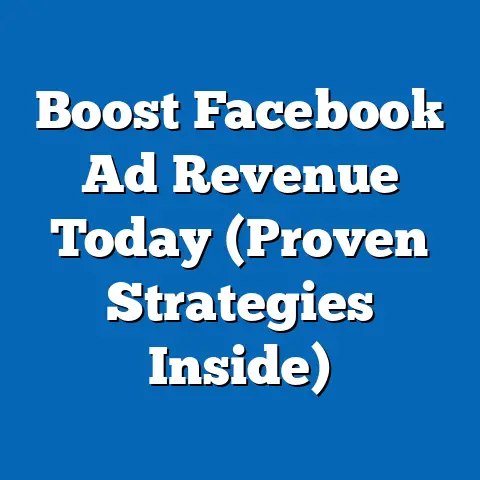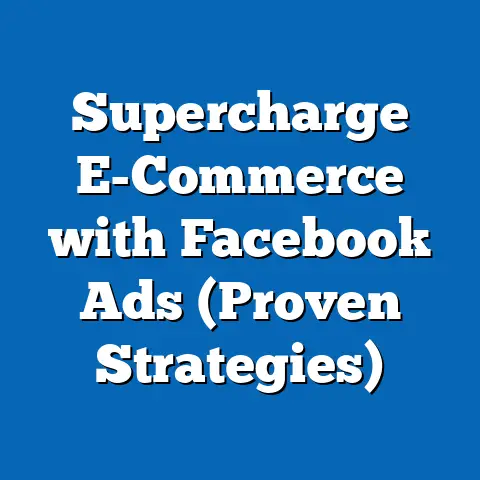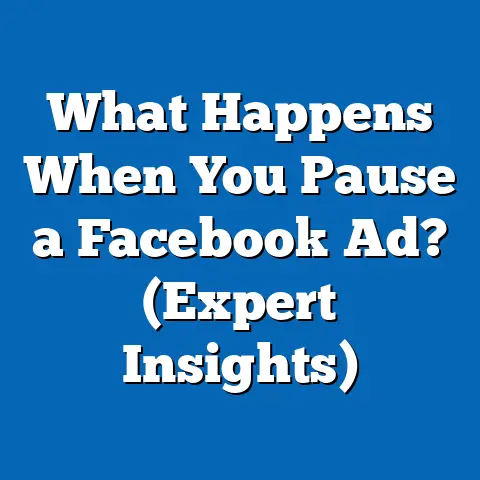Maximize CPA with Ideal Facebook Ads (Proven Strategies)
Maximize CPA with Ideal Facebook Ads: Proven Strategies
Imagine cleaning your house. If you have the right tools – a powerful vacuum, effective cleaning solutions, and a systematic approach – the task feels manageable and efficient. But without them, you’re just pushing dirt around, wasting time and energy. Facebook advertising is similar. With the right strategies, you can significantly reduce your Cost Per Acquisition (CPA) and boost your overall campaign performance.
Facebook remains a powerhouse in the digital marketing landscape. Billions of people use it daily, making it a prime platform for reaching potential customers. But with so much competition, it’s crucial to optimize every aspect of your campaigns to get the best return on your investment. Let’s explore how to clean up your Facebook Ads and make them shine!
1. Understanding CPA in Facebook Ads
What is CPA?
CPA, or Cost Per Acquisition, represents the cost you incur for each conversion (acquisition) achieved through your Facebook ad campaigns. A conversion could be anything from a sale to a lead generation form completion, an app install, or even a registration for a webinar.
Why is CPA Important?
CPA is a critical metric because it directly reflects the efficiency of your advertising spend. It’s the bottom line: how much are you paying to get a customer? A lower CPA generally indicates a more effective ad campaign, leading to a higher Return on Investment (ROI). Imagine paying $5 to acquire a customer who spends $50 versus paying $20 for the same customer. Obviously, the $5 CPA is far more desirable.
Interpreting CPA
Interpreting your CPA involves comparing it to your profit margins and business goals. If your CPA is higher than your profit margin, you’re essentially losing money on each acquisition. It’s like selling a product for $10 but spending $12 to acquire the customer – not a sustainable business model! Therefore, understanding and actively managing your CPA is paramount for long-term success. I’ve seen businesses completely transform their profitability simply by focusing on reducing their CPA.
Takeaway: CPA is your key to profitability. Understanding it and actively working to lower it is essential.
2. Setting Clear Objectives
Why Clear Objectives Matter
Before you even think about creating an ad, you need to define what you want to achieve. Setting clear and measurable objectives is the foundation of any successful Facebook ad campaign. Are you looking to generate leads, drive sales, increase app installs, or boost brand awareness? Each objective requires a different approach.
Aligning Objectives with CPA Goals
Your objective directly impacts your CPA goal. For example, if you’re aiming for lead generation, you might be willing to pay a higher CPA than if you’re simply trying to drive traffic to your website. Let’s say you’re running a campaign to get people to sign up for a free trial. You might aim for a CPA of $10 per trial sign-up. If you’re trying to sell a high-ticket item, you might be willing to pay a CPA of $50 or more.
Examples of Common Objectives
- Lead Generation: Collecting contact information from potential customers.
- Sales: Driving direct sales of your products or services.
- App Installs: Encouraging users to download and install your mobile app.
- Website Traffic: Increasing the number of visitors to your website.
- Event Registrations: Getting people to sign up for a webinar, conference, or other event.
When I start a new campaign, I always ask myself, “What’s the one thing I want people to do after seeing this ad?” Answering that question helps me define a clear, measurable objective.
Takeaway: Define your objectives before anything else. This will guide your entire campaign strategy.
3. Targeting the Right Audience
The Power of Precision Targeting
Targeting the right audience is perhaps the most crucial aspect of maximizing your CPA. Think of it like fishing: you wouldn’t use the same bait to catch a trout as you would to catch a shark, right? Facebook’s targeting options are incredibly powerful, allowing you to reach specific demographics, interests, behaviors, and even custom audiences.
Facebook’s Targeting Options
- Demographics: Age, gender, location, education, job title, etc.
- Interests: Hobbies, passions, topics they’ve shown interest in on Facebook.
- Behaviors: Past purchase behavior, device usage, travel habits, etc.
- Custom Audiences: Uploaded lists of customers, website visitors, app users.
- Lookalike Audiences: Audiences that resemble your existing customers or website visitors.
Building Effective Audience Segments
To build effective audience segments, start by understanding your ideal customer. What are their interests? Where do they live? What do they do for a living? Use this information to create targeted audience segments within Facebook Ads Manager.
- Lookalike Audiences: These are incredibly effective. Facebook finds users who share similar characteristics and behaviors as your existing customers. I’ve seen campaigns where Lookalike Audiences outperform other targeting options by a significant margin.
- Retargeting Strategies: Don’t forget about retargeting! Show ads to people who have visited your website, watched your videos, or interacted with your Facebook page. These users are already familiar with your brand, making them more likely to convert.
Real-World Examples
I once worked with a local bakery trying to increase cake orders. Instead of targeting everyone in the city, we focused on people who had recently engaged with wedding-related content on Facebook and lived within a 10-mile radius of the bakery. The result? A 40% reduction in CPA and a significant increase in cake orders. That’s the power of precise targeting.
Takeaway: Master Facebook’s targeting options. The more precise you are, the lower your CPA will be.
4. Crafting Compelling Ad Content
The Anatomy of an Effective Ad
Even with perfect targeting, your ad won’t succeed if the content is lackluster. Compelling ad content is the bridge that connects your product or service to your target audience. It needs to grab their attention, pique their interest, and persuade them to take action.
Essential Elements of Ad Copy
- Headlines: The first thing people see. Make them attention-grabbing and benefit-driven.
- Descriptions: Provide more detail about your offer and why people should care.
- Calls-to-Action (CTAs): Tell people exactly what you want them to do (e.g., “Shop Now,” “Learn More,” “Sign Up”).
The Importance of Visual Content
Visual content, such as images and videos, plays a crucial role in capturing attention and driving conversions. High-quality images and videos are more likely to stop users in their tracks and encourage them to engage with your ad. I always recommend using professional-quality visuals that are relevant to your target audience and offer.
A/B Testing Ad Creatives
A/B testing, or split testing, is the process of comparing two or more versions of an ad to determine which one performs better. Test different headlines, descriptions, images, and CTAs to see what resonates best with your target audience. Facebook Ads Manager makes A/B testing relatively easy.
Case Studies: High-Performing Ad Content
I remember a campaign I ran for an e-commerce store selling eco-friendly products. We tested two different images: one showing the product in a studio setting and another showing the product being used in a natural environment. The latter outperformed the studio shot by 30%, highlighting the importance of showcasing the product in a relevant context.
Takeaway: Create compelling, visually appealing ads that speak directly to your target audience. A/B test everything to find what works best.
5. Optimizing Ad Budgets and Bidding Strategies
Budgeting Options on Facebook
Facebook offers several budgeting options, including daily budgets and lifetime budgets. Daily budgets allow you to set a specific amount to spend each day, while lifetime budgets allow you to set a total amount to spend over the entire duration of your campaign.
- Daily Budgets: Ideal for ongoing campaigns where you want to maintain a consistent level of spending.
- Lifetime Budgets: Ideal for campaigns with a specific end date, such as a promotion or event.
Choosing the Right Bidding Strategy
Your bidding strategy determines how Facebook bids on ad placements. Different bidding strategies can help you maximize your CPA, depending on your goals and budget.
- Cost Cap: Facebook tries to get you the most conversions possible while staying under your specified cost per result.
- Bid Cap: You set the maximum amount you’re willing to pay for each conversion.
- Target Cost: Facebook aims to achieve an average cost per result that matches your target.
Monitoring and Adjusting Budgets
It’s crucial to monitor your campaign performance regularly and adjust your budgets accordingly. If you’re seeing a high CPA, you might need to decrease your budget or refine your targeting. Conversely, if you’re seeing a low CPA, you might want to increase your budget to scale your campaign.
Takeaway: Carefully choose your budgeting and bidding strategies. Monitor your performance and adjust as needed to optimize your CPA.
6. Analyzing Campaign Performance
Key Performance Indicators (KPIs)
To effectively analyze your campaign performance, you need to track the right Key Performance Indicators (KPIs). These are the metrics that provide insights into how well your campaigns are performing and whether you’re achieving your goals.
- CPA (Cost Per Acquisition): As we’ve discussed, this is the cost you incur for each conversion.
- CTR (Click-Through Rate): The percentage of people who see your ad and click on it.
- Conversion Rate: The percentage of people who click on your ad and complete the desired action (e.g., make a purchase, fill out a form).
- Reach: The number of unique people who have seen your ad.
- Frequency: The average number of times each person has seen your ad.
Facebook Analytics and Ads Manager
Facebook Analytics and Ads Manager are powerful tools for gathering insights into your campaign performance. They provide a wealth of data on your audience, ad performance, and overall campaign effectiveness. I spend a good chunk of my time digging into these tools, looking for patterns and opportunities to improve.
Interpreting Data
Interpreting data involves identifying trends and patterns that can inform your future campaigns. For example, if you notice that your CTR is low, you might need to improve your ad copy or visuals. If your conversion rate is low, you might need to optimize your landing page or offer a more compelling incentive.
Takeaway: Regularly analyze your campaign performance using Facebook Analytics and Ads Manager. Use the data to make informed decisions and optimize your campaigns.
Conclusion: Putting it All Together
Maximizing CPA with Facebook ads is an ongoing process that requires careful planning, execution, and analysis. By setting clear objectives, targeting the right audience, crafting compelling ad content, optimizing your budgets and bidding strategies, and analyzing your campaign performance, you can significantly reduce your CPA and drive better results.
Remember, there’s no magic bullet. It’s a combination of all these elements working together that will ultimately lead to success. Don’t be afraid to experiment, test new ideas, and learn from your mistakes. Like cleaning, the more you practice, the better you’ll get at it. Now, go out there and clean up your Facebook Ads!
Now that you’ve armed yourself with these proven strategies, it’s time to take action. Start by reviewing your existing campaigns and identifying areas for improvement. Implement the tips and techniques discussed in this article, and track your results closely. With dedication and persistence, you can unlock the full potential of Facebook advertising and achieve your business goals.





